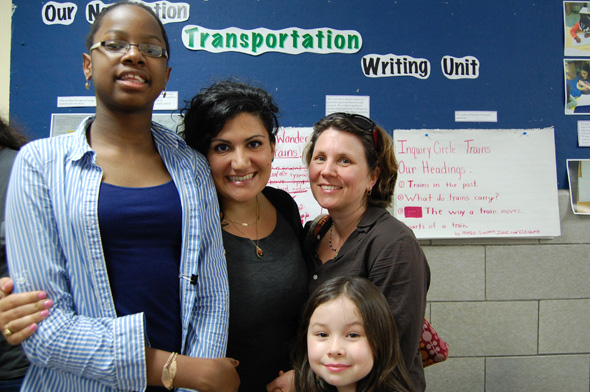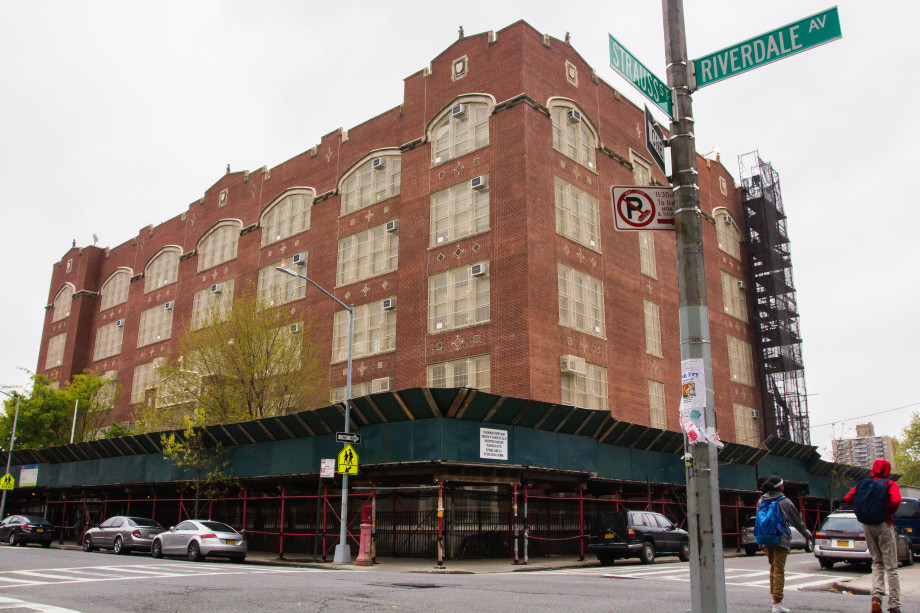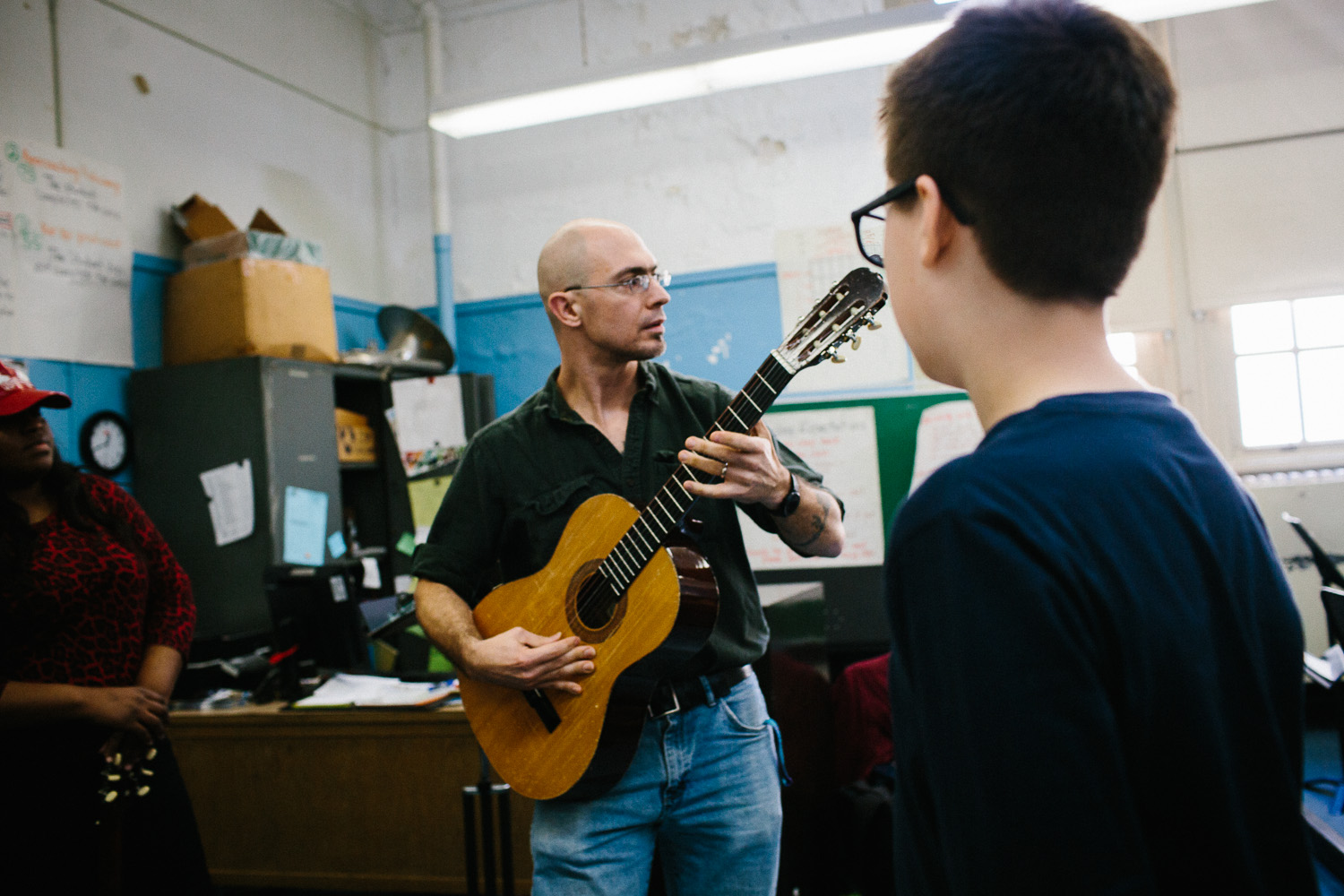
A long-faced fifth-grade boy sat alone on a big white couch staring at his knees, his blond hair hanging over his eyes. A short distance away, a multiracial girl sat on the floor with her knees to her chest, her lower lip extended in a pout. The two looked perfectly miserable, despite the happy din of other students surrounding them.
An African-American girl, whose job it was to bring the two together, surveyed the lonely pair. Momentarily flummoxed, she looked up at the smiling woman standing behind her.
“What do I say?” the girl asked Sahba Rohani, the school’s Director of Community Development, who looked down at her with a wide smile.
“You can make it up,” Rohani answered, leaning over maternally to give the girl a gentle pat on the back.
Shuffling up to the moping boy, the girl asked, “Why are you sitting alone?” Another fifth-grade boy approached the pouting girl with the same question. In seconds, all the students were gathered together on the floor, planning a game for everyone to play.
Then, Rohani hopped over to break the scene. “So nice!” she exclaimed, her big, dark eyes wide with enthusiasm. During this and several other theater exercises, Rohani helped the students imagine creative ways to solve problems by asking questions and, most importantly, listening.
Acting out scenarios is part of Community Builders training, a program Rohani helped develop at Community Roots, a progressive charter elementary school founded in 2006 in Fort Greene, Brooklyn. Fifth-graders work eat and play with younger classmates during lunch and recess, helping to resolve conflicts and ensuring that nobody feels left out.
Community Builders is just one of Rohani’s many projects to make sure that every student, parent, and teacher at this especially diverse school is heard, no matter what their race, economic class, or beliefs may be. It’s her role, as Community Roots’ first Director of Community Development. Schools are full of moving parts, and it can be easy for a person or an idea to go unnoticed.
While other schools have created positions to prevent this from happening, such as diversity coordinators and parent coordinators, Rohani’s approach is unique. Influenced by both her Bahá’í faith and her mentor at Teacher’s College, she is inclined to support parents rather than manage them and listen to students rather than teach them.
Rohani has worked at the school since its opening, acting as a kindergarten teacher until she assumed her current position two years ago. When Principal Allison Keil suggested that she take on a leadership role at the school, Rohani was so excited about the idea that she stayed up all night writing her own job description.
“An active community is one where the participants, one and all, feel purposeful, inspired, and valued,” she wrote. “It is characterized by not only tolerating differences but by cultivating a spirit of unity within diversity.”
In her work at Community Roots, Rohani’s words often reflect the theme of unity. Unity is not simply an idea she admires; it’s a religious preoccupation. Rohani’s parents are Iranian immigrants and she was raised in the Bahá’í faith.
One of the religion’s central tenets is the inherent unity of global society: “The fundamental purpose animating the Faith of God and His Religion is to safeguard the interests and promote the unity of the human race, and to foster the spirit of love and fellowship amongst men,” wrote Bahá’u’lláh, who founded the Bahá’í faith during the late 1800s.
Rohani’s voice warms when she speaks of her religion, saying that it was an essential focus in her upbringing. Before attending graduate school, Rohani spent 3 years in Haifa, Israel at the Bahá’í International Headquarters, working in grassroots educational programs.
On a February day, there was a large postcard on her office bulletin board that read “PRACTICE UNITY” in simple, block letters. At Community Roots, Rohani considers her work a “service to humanity.”
“My work is my life. It’s very in line with what I believe,” she said.
Although she admits that her role sometimes feels ambiguous, Rohani has made the position her own. She has listened to the advice of many different parents and supported activities that appeal to everyone, including a book club, an adult chorus, and a cooking club. Through helping students volunteer at a nearby homeless shelter, she has found herself on the shelter’s board.
She encouraged parent Patti Murphy to expand a program to arrange play dates for students whose parents wouldn’t otherwise meet, and photos from these outings are now posted on the walls of Community Roots’ classrooms. “She has been able to strengthen those connections that are so necessary between parents, students, and the school,” Murphy said.
Rohani’s efforts are well-supported by the Community Roots administration, which is committed to having a diverse student body through aggressive outreach efforts. New York City Department of Education data shows that 42 percent of its students are black, 37 percent are white, 13 percent are multiracial, with the remaining students being Hispanic or Asian. Beyond being racially diverse, 17 percent of the school’s students require special education.
Keil, one of the school’s founders, said it was always her dream to create a diverse school, but she is quick to note that things aren’t as simple as bringing many different people together and hoping everything works out. “What we learned along the way is that diversity takes a lot of work,” she said.
A great deal of this work lands on Rohani’s shoulders. Because every family communicates differently, she sends emails, prints fliers, and even text-messages some parents to remind them of school events. Walking down the hallway is no simple task for her; students, teachers and parents constantly stop her to discuss various concerns, and because she always responds with her characteristic wide smile, it can be a while before she makes it to her destination.
She is frequently interrupted by students in her office, who wander in to solicit a hug. After-school parent activities sometimes keep her at the school past 8 pm, leaving the sink in her office piled high with dishes. She has even helped parents with their resumes in her spare time.
“I’m exhausted most of the time,” she admitted. “It’s a big challenge for me not to take on every problem that exists.”
But it’s clear that Rohani has created an ideal job for herself. She always knew she wanted to work with school communities, but was told the position didn’t exist. “I started to look everywhere for programs that were nebulous enough to do what I wanted to do,” she said.
She found Hope Leichter at Teacher’s College, who shares many of her ideals. Leichter, author of “Families and Communities as Educators,” remembered Rohani as one of her favorite students, bemoaning the fact that she never pursued a doctorate degree. Leichter praised Rohani’s “willingness to assume that people of varying backgrounds and varying ages can learn from each other,” and is both pleased and unsurprised that Rohani has prioritized working with families at Community Roots.
“It’s a model that deserves to be emulated and taken very seriously,” she said.
While Rohani’s position does not exist outside of Community Roots, she hopes to share her ideas with other schools in the future. But for now, she is enjoying watching her dreams and ideals become a reality.
One Friday morning, she hurried up and down the hallway, smiling so widely that tears formed in the corners of her eyes as she helped teachers and students get ready for Buddy Read, a school-wide activity Rohani has fostered. “It’s my favorite morning of the month,” she whispered to a parent peeking into a classroom.
It was an idyllic sight; kindergartners were paired off with students from the third grade, the older children helping the younger ones to read. Black, White, Hispanic, and Asian children of different ages sat bunched together on couches and chairs, heads bumping as they bent over picture books. A tiny girl wandered into Rohani’s knees, looking lost.
“Where’s your buddy?” asked Rohani. The kindergartner shook her head.
Rohani, scanned the classroom, her hands resting on the girl’s head. “There she is, look!” A worried-looking third grader hurried over to grab her partner by the hand. Rohani beamed, and the tears in her eyes grew slightly larger.
For a person who religiously strives for unity within her school, even the smallest connections count. “I have no doubt that this is the path I need to be on,” she said afterwards.




Thank you for this beautiful article about Sahba. She deserves it!
Somehow you were able to capture the magic that is Sahba, and the magic that is Community Roots! Thank you.
Wonderful story. Congratulations Saahba. Find this link posted on Education Under Fire’s website with the notation: This story demonstrates the spirit of a peoples now systematically deprived of the right to higher education by the Iranian government. These are the ideals held by Baha’is. As such, the denial of access to the right to higher education can be seen as a crime against ALL humanity.
what a wonderful story! that is what we need in public school. Good job Sahba we are proud of you.
This story has inspired me so much — I have always been interested in community development in school settings… now I know how it can be possible to take upon that role!
Job well done Sahba joon. So proud of you.
Love
Mahshid